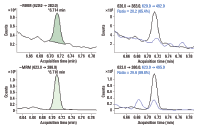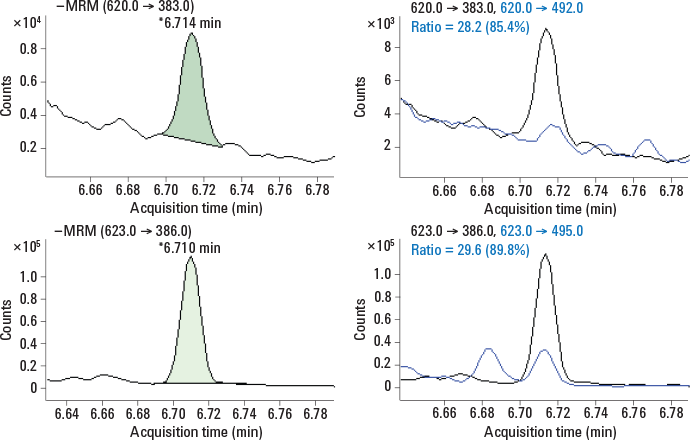Access Agilent eNewsletter, August 2014
>> Update My Profile | Subscribe to Access Agilent | Article Directory

Tips and tricks: Solutions for forensic drug analysis
By Graham Farrell
Agilent CSD Science Writer/Editor
For general drug screening, generic sample preparation methods are required to extract a wide range of compounds and compound classes. Non-specific analytical methods allow you to characterize a large number of compounds in a reasonable length of time. On the other hand, confirmatory tests on specimens designated as “non-negative/presumptive positive” typically target specific drugs or drug classes. This level of specificity lets you refine sample prep methods and optimize analytical methods to achieve the lowest detection limits and highest throughput. In this article we highlight general tips and specific solutions for the forensic drug analyst.
Key workflow considerations for forensic drug analysis
- Depending on the analytical instruments used, sample matrixes – such as blood, plasma, and urine – can adversely affect your system and columns. For these sample types, reliable sample prep is an essential part of the workflow.
- Selection of GC or LC columns and sample prep techniques should be based on return on investment – specifically, time and cost when compared to workflow performance and results.
- Ion suppression caused by sample matrixes can negatively impact your MS results, when using an electrospray source.
- Many illicit drugs are challenging to analyze because of factors, such as volatility, hydrophobicity, and “stickiness” to glass and plastic.
Choosing the right sample prep
Select your sample prep method with your analytical goals and requirements in mind – including your lab affiliation/profile, regulatory environment, matrix, target analytes, cost considerations, and detection method. There is no standard procedure for defining a comprehensive sample preparation method, and various published procedures are often complementary, because they focus on different targeted analytes. Selecting a flexible sample preparation approach such as mixed-mode solid phase extraction (SPE) gives you a versatile tool for sample cleanup, suitable for both general screening and targeted confirmation methods. Agilent Bond Elut Plexa PCX is a good first choice for general forensic applications.
Specific drug analysis
To test for a specific drug, tried-and-tested methods can be used and brought up to date by taking advantage of improvements in instrument performance. In our analysis, we employed the lower chemical background and higher sensitivity provided by triple quadrupole GC/MS/MS to develop an improved method for detecting marijuana in hair.
 Enlarge
Enlarge
Figure 1. MRM traces for quantifying transition (left), and quantifying and qualifying transitions (right) for the 0.002 pg/mg LOD of THCA (above) and deuterated standard (below) spiked into a hair sample.
Testing hair for illicit drugs has been practiced for over 50 years, due, in large part, to the ability to detect drug use over a longer period of time. As compared to other biological matrixes, many drugs are well preserved in hair. Marijuana is one of the drugs tested most often in forensic and drug screening applications. The parent compound, tetrahydrocannabinol (THC), is found in higher concentration in hair samples, but detection of the acid metabolite 11-nor-D9-tetrahydrocannabinol-9-carboxylic acid (THCA) is preferred, to eliminate the possibility of potential environmental contamination from marijuana smoke. In our study we used the time-tested technique of heart-cutting to improve chromatographic separation of THCA. We employed microfluidics-aided backflushing and low thermal mass (LTM) column modules, using Bond Elut Certify sample prep with Agilent J&W DB-1ms and DB-17ms LTM, in an Agilent 7890A GC and Agilent 7000 Series Triple Quadrupole GC/MS.
This new method delivered sensitive and robust detection and quantification of THCA in hair (LOD 0.002 pg/mg, LOQ 0.01 pg/mg) with run times of only seven minutes, and cycle times of nine minutes (Figure 1).
Full details of this work are described in Agilent Application Note 5990-7535EN.
Effective solutions for forensics analysis
LC/MS methods are rapidly becoming an important tool for drug screening and confirmation because they typically don’t need a derivatization step, and are often faster and less complicated than GC/MS methods. However, as we’ve seen, Agilent triple quadrupole GC/MS offers sub-picogram sensitivity, MS/MS selectivity, and minimal sample prep.
You will find much more information on drug sample prep, separation, and detection in Agilent’s latest Quick Reference Method Guide to Drugs of Abuse (5991-3883EN). Then take the time to explore our full range of advanced detection and analysis technology, which covers all standard criminalistics processes. You will discover ion trap GC/MS systems with unmatched sensitivity, as well as LC/MS analyzers with reliable, day-to-day performance. In addition, you will learn how advanced automation and workflow management capabilities are enabled by Agilent MassHunter and OpenLAB software.
For Forensic Use.
>> Update My Profile | Subscribe to Access Agilent | Article Directory
